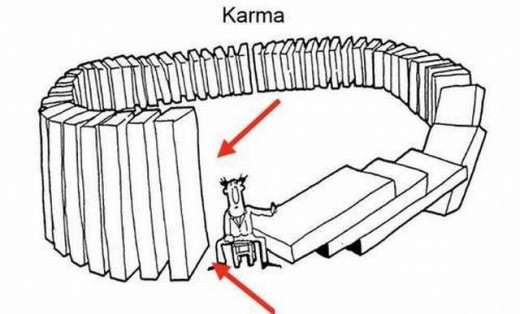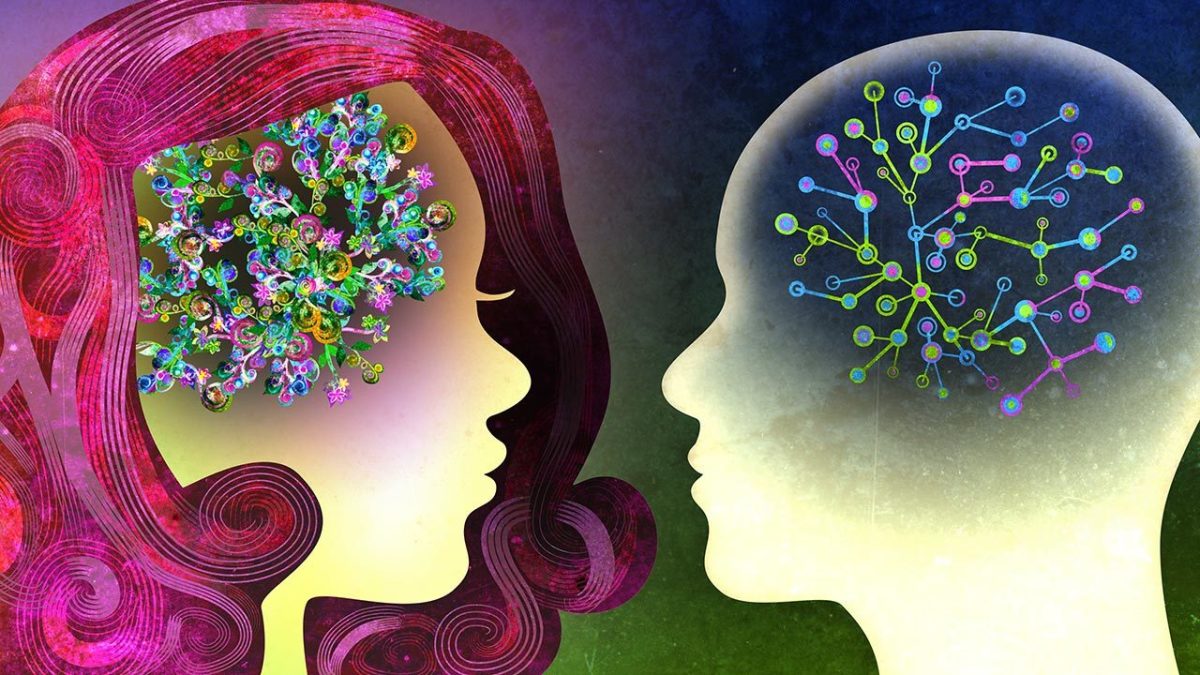Essay on Karma and Meditation

Karma
It has been a few years now since I have come to understand that everything I experience is nothing more than how my mind perceives it to be. I think of everything like clouds: impermanent formations of molecules that seem different and distinct from one an other but in fact bleed together. I first began to understand this when I was twelve and learned about nouns being persons, places, things, or ideas. I thought to myself, what would a tornado be. I classified it as a thing at first, but then I started thinking more and more about it. A tornado is not one thing, but made up of many smaller things: cloud matter, dirty, air, debris, cows, etc. A tornado is in fact an idea. It was not long until this belief generalized to other persons, places, and things. A city is a compilation of matter at a certain location that many people live or work at; it is an idea. A person is a compilation of organs systems, each made of smaller systems, all orchastrated by a mind; a person is an idea. A table is just a compilation of atoms in a shape that fulfills a human purpose; it is an idea. All nouns are ideas.
Around my junior year in college, while I was studying the function of our brain that determines how we generalize and discriminate between objects, I became fascinated with Bugs Bunny. That is to say, I became fascinated with the fact that my brain chose to generalize his appearance with that of a rabbits, despite the fact that he is shaped absolutely nothing like a rabbit (Goldstone). I furthered my all-nouns-are-ideas theory to the everything-is-a-cloud theory I expressed at the beginning of this document. The theory goes something like this: when I look at a cloud that is shaped like a cow, my mind recognizes it as looking like a cow because of its ability to generalize. Really, the cloud is just an arrangement of particles. Cows, however, are also just constructs in my mind. They too are just arrangements of particles, transmuted from one state into another. The cow was formed at one point and will dissipate at another point when it dies and decomposes. Furthermore, the cow is not even made of the same particles throughout its whole life. As tissue dies and gets replenished, the cows body in fact changes. Even the cows mind is not the same throughout its life as it learns now things. All life is like this, impermanent and illusory like a cloud, just a construct of the mind.
I began doing weird things like putting my hand on a table and imagining the particles of my hands rubbing off on the table, and the particles of the table rubbing off on my hand and wondering where did my hand end and the table begin. Like two clouds colliding we were enmeshed, and therefore no true difference could be determined. This was of course before I began meditating, and instead elected to live my life in a strange existencial daze. I thought I had understood Zen in this mindset. I thought that I had achieved something great because I had begun to see the world as illusory and impermanent, just like the Buddhist scriptures said it was. But without actually practicing meditation, I was unable to feel the happiness that they talked about as well.
In my quest to see all nouns as ideas, I had forgotten, ironically enough, to think about the things that everyone considers to be ideas. I am referring to things like love, compassion, empathy, hope, and happiness. I was so busy focusing on the esoteric aspects of Buddhist philosophy, that I forgot to hone my understanding of these important fields. And that’s where karma comes in. If physical objects are nothing more than constructs in the mind determined by generalization and discrimination, then epiphenomena such as love, happiness, and the like must also be constructs in the mind. And just like their physical counterparts, these entirely mental constructs grow and change as the perceiver alters his perception of them.
When I was a child at some point I must have learned what shoes were. I must have after that learned all the different varieties of shoes as I came to experience them. At some point I must have encountered a sandal and learned that it was a shoe, thus expanding the construct of shoe in my mind. The same would have happened when I first saw a boot, or a high heel, or clog. Each one expanding the construct of what a shoe is in my mind. (Daelli, Valentina et al 2010) But epiphenomena are slightly different than shoes. I cannot do shoes, or be shoes. I can, however, do good unto others, or be aggressive.
Researchers in the Donald Study, demonstrated how mere exposure to negative stimuli can alter how a subject perceives the world around them. But research has also demonstrated that behavior alters how one perceives the world. One particular experiment (find citation) was conducted on people who were told to engage in a very boring task. After the boring task was completed the participants went into a room and reported to someone how they felt about the experiment. Half of the participants first had to go back to a waiting room before this part where they met a person who they were led to believe was going to participate in the boring task next. They were instructed to lie to this person and say that it was not boring. Those who lied and then went on report about how they felt about the experiment ended up reporting that it was less boring than those who did not tell the lie. This is in support of the belief that a person’s actions must be congruent with their beliefs, and if an action is performed that is not in accordance with feelings and thoughts, the mind may alter itself to make its own feelings in line with the action. This supports the Fourth Path of Nonvirtuous Action. A liars karma may be to believe their lie after telling it.
Actions affecting thought constructs are also demonstrated in the study by Thomas Mussweiler, in which subjects who performed stereotypical actions then felt the corersponding stereotype. (Mussweiler 2006)
The phrase, “We color our own world,” comes to mind here. How we perceive the world is often described by the analogy of putting on colored lenses. Some see the world in blue, others in red. But what many people do not realize is that these colors are generated by us. The reason one person may perceive the world a certain way is because they have themselves acted that way towards others. It is no wonder that liars and backstabbers are often mistrustful. Killers are often preoccupied with self-preservation. The way we treat others determines how we perceive the world treating us.
To illustrate this, I will give an example from my own life. I am an introverted person, who often finds himself bothered by other people who wish to talk with me. I am well spoken and not at all afraid of conversation so my dislike of it is not derived from fear but from simply being asocial. Thus, when I do meet someone I want to strike up a conversation with I often find it difficult to do so. I am articulte and can think of many things to say, but for some reason whenever I have an interest in speaking with someone, I cease up and become too nervous to do so. This is my karma. I have come to realize that the reason I cease up when trying to initiate conversation with someone is because I am afraid I am bothering them. I have this fear because of all the times I have been bothered by people trying to start conversations with me.
Everytime I allowed my introversion to go that one step further and blow someone off, or everytime I endured someones presence but secretly thought in my head of how I’d like nothing more but to get away from them, I was reinforcing a construct in my mind. That construct is one that says people who are trying to start conversations are annoying. This generalized to include myself in the category of “people” and therefore I am afraid that I am being annoying whenever I try to start a conversation.
The difficulty comes when we try to examine exactly how I can stop myself from reinforcing this construct. I cannot very well change the fact that I’m an introvert. I cannot, by the power of will alone, stop someone from annoying me. And it would be unhealthy to adopt a blanket policy of engaging in conversation with every single person who attempts it since there are people who are genuinely going to waste my time. This is where meditation comes in; specifically compassion meditation. I, just like in the Donald study, am affected by the things I am exposed to. Thus, the more I think about how annoying people are, the more likely they are to annoy me. But if I focus on the things I do like about people, on the fact that I do care about people, and on the things that it would take to make others happy, I exercise my construct for compassion. Much like a muscle in the body, this construct is strengthened with exercise, and the construct for asocial behavior atrophies with disuse. Throughout my time practicing compassion meditation, I have noticed a marked increase in my ability to not only tolerate, but enjoy others conversation. And with this increase for tolerance has come an increase in confidence when I attempt to engage others in conversation. By altering my mental constructs, I have altered my karma.
Each one of the Ten Paths of Nonvirtuous Action lead to a karmic consequence comparable in type and magnitude to the behavior of the individual following that path (Lam Rim Chen Mo 2002). Violent people are more likely to interpret ambiguous behavior as being potentially violent because the contruct is constantly active in their minds. Thieves are more likely to fear being stolen from because they know just how easy it is to steal. Those who attempt to steal the spouses of others are more likely to fear that their own significant others might cheat on them. As mentioned earlier, liars are likely to believe that they are being deceived. Those who sow decension are likely to strongly feel its effects when they perceive it in the world. Those who speak harshly will receive even contructive criticism as being harsh. Those who engage in gossip may miss important facts because they are more likely to assume that any given conversation is nothing more than idle chitchat. Those who crave will feel the ill effects of not getting what they want. Those who have ill will are likely to believe others have ill will towards them. And those who misunderstand the principles of karma are caught in a dangerous loop of thinking they have figured something out but continue suffering for their ignorance. (Anand, 2009) It is this last concept that I wish to talk about next.
Karma is not magic as many people seem to believe. It is not the recompense of a vengeful God or the simple result of a cosmic debt. Furthermore, karma is not polar in nature. Most of the time, when people misunderstand the rules of karma, they believe that it is good or bad, black or white, when in reality karma has a wide array of colors, and shades of each color. I prefer to think of every psychological construct as a type of color. Aggression perhaps is red, and compassion yellow, excitability is pink, and maybe laziness is blue. In anycase, each one of these things can bring karma onto the person behaving in that way. The degree to which a person acts that way, and thus the strength the corresponding construct has in their mind, would be like the shade of the color. If someone has only been a little lazy, then they color their world blue, but only a very light shade of blue, and so when they encounter someone who isn't doing work, they're just a little bit more likely to interpret the behavior as laziness. Whereas a person who is very mean, harsh, and hostile will color their world with a deep crimson of aggression, and therefore will interpret even the slightest amount of acertiveness as aggression against them.
By changing the way we color our world, we change the things we can do in it. There are certain colors which we enjoy and will happily pass through, but there are other colors which we tend to avoid. In the previous paragraph, red is a color which we would want to avoid. The more of our world we color in it, the more of it we close ourselves off to. The more people we see as being aggressive, the more places we feel we are likely to be on the receiving end of aggression, the more things we avoid. And the more things we avoid, the less opportunities we have. When we avoid someone because we interpret their behavior as aggressive, then we may have missed an opportunity for anything from a helpful piece of advice to a deep and meaningful relationship. All because we have a construct activated in our minds from our own doing.
Coloring the world with only things that our pleasing to us also has its downsides, as we are more likely to accept things into our lives that are in fact dangerous to us. And that would be our karma. Walking around in a happy stupor may be enjoyable, but is not true bliss anymore than fear of aggression is. This too is simply part of the cycle of karma; an overactive construct in the mind taking its toll on the activator of said construct.
With the knowledge that happiness is not always good and fear not always bad, I would like now to talk about ignorance. Ignorance is what determines whether or not karma is going to affect us in a way that is beneficial or not. If I ignorantly choose to tolerate and enjoy and be attracted to and get warm fuzzy feelings from every single person I meet, my karma is going to come back and get me when I try to hug a serial killer. I would do very well to avoid serial killers and even to treat them with a certain degree of hostility in order to maintain the construct that they are social pariahs in my mind. If I remove that construct then I will accept them as a perfectly natural part of our world and will be more likely to be victimized by one.
On the opposite side of this coin, if I am mean and treat everyone I meet like they are social pariahs, then my karma will be that I have become a social pariah myself by my own alienation from society. As we color our world, it in turn colors us, which makes us more likely to continue the pattern. This is what is meant by karma's effects multiply in intensity. The more we do something, the more we are likely to do it in the future. It is a vicious circle, and difficult to get out of. That is why Buddhists talk of breaking the cycle of karma, and this is accomplished through meditation.
Meditation is almost like a cheat, or a glitch in the system. It allow a practitioner to go into a hyper-focused state of mind and actively build up or tear down a construct that may have otherwise taken years to accomplish. By meditating on compassion, I have increased my capacity for compassion more so than if I had forced myself to converse with ten people every day. I am now able to converse with those people without struggling and am also much happier than if I had forced myself. I think of meditation like the training simulators in The Matrix. But instead of learning kung fu or jiu jitsu I am simulating my ability to be compassionate, or observant, or introspective and I am working away at my ignorance. Thus, meditation is a glitch in the karmic system. Rather than doing, as the word karma implies, I am able to alter my reality by cognition, and my actions follow suit.
Works Cited
Mussweiler, Thomas. Doing is for Thinking! Stereotype Activation by Stereotypic Movements. Association for Psychological Science. 2006
Lam Rim Chen Mo. Great Treatise on the Stages of the Path to Enlightenment. 2002.
Daelli, Valentina; van Rijsbergen, Nicola J.; Treves, Alessandro Brain. How recent experience affects the perception of ambiguous objects. Elsevier Science. 2010
Goldstone, Robert L. Infuences of categorization on perceptual discrimination. Journal of Experimental Psychology: General. Vol 123(2), Jun 1994, 178-200.
Anand, Jyoti. Psychological healing and faith in the doctrine of Karma. Mental Health, Religion & Culture. 2009. Vol 12. Is. 8.








